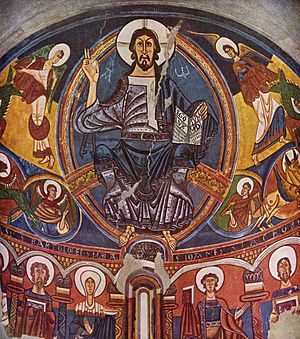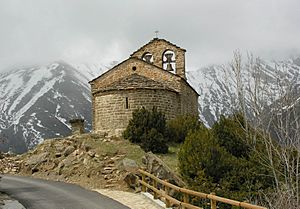La Vall de Boí facts for kids
Quick facts for kids
La Vall de Boí
|
|
|---|---|
|
Municipality
|
|
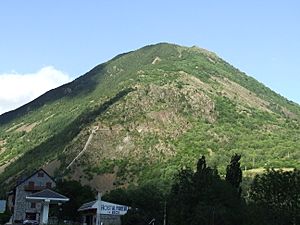
Roca de la Feixa mountain seen from Barruera
|
|
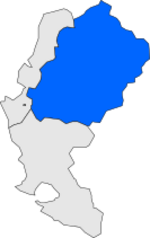
Location in Alta Ribagorça county
|
|
| Sovereign state | |
| Community | |
| Region | Alt Pirineu |
| County | Alta Ribagorça |
| Province | Lleida |
| Area | |
| • Total | 219.5 km2 (84.7 sq mi) |
| Elevation | 1,111 m (3,645 ft) |
| Population
(2018)
|
|
| • Total | 1,022 |
| • Density | 4.656/km2 (12.059/sq mi) |
| UNESCO World Heritage Site | |
| Official name | Catalan Romanesque Churches of the Vall de Boí |
| Includes | |
| Criteria | Cultural: (ii)(iv) |
| Inscription | 2000 (24th Session) |
| Area | 7.98 ha (19.7 acres) |
| Buffer zone | 3,562 ha (8,800 acres) |
La Vall de Boí is a beautiful valley and a municipality in Catalonia, Spain. It's found in the Alta Ribagorça area, right on the edge of the Pyrenees mountains. In 2022, about 1,090 people lived there.
This valley is super famous for its nine old churches built in the Early Romanesque style. This means it has the most Romanesque buildings in one small area in all of Europe! Because of their importance, UNESCO named them a World Heritage Site in 2000. The valley also has the highest ski resort in the Pyrenees, called Boí-Taüll, and is next to the Aigüestortes i Estany de Sant Maurici National Park.
Contents
Villages of La Vall de Boí
La Vall de Boí is made up of several small villages, each with its own charm. Many of these villages are home to the famous Romanesque churches.
- Barruera, 219 people
- Boí, 221 people
- Les Cabanasses, 6 people
- Caldes de Boí, 5 people
- Cardet, 12 people
- Cóll, 37 people
- Durro, 110 people
- Erill la Vall, 98 people
- Pla de l'Ermita, 133 people
- Saraís, 8 people
- Taüll, 273 people
History of La Vall de Boí
The high valleys of the Pyrenees, like La Vall de Boí, were not taken over during the Moorish conquest of Spain. The first Christian areas here were set up in the 800s. The local leaders didn't pay much attention to their Frankish rulers. Many people living here were Basque.
Over time, the valley belonged to different powerful groups. First, it was part of the county of Toulouse, then the County of Ribagorza. In the 1000s, it became part of the County of Pallars. Finally, in the 1100s, it joined the Kingdom of Aragón. Because of its important location, the valley has many old castles, but most are not well preserved today.
Amazing Romanesque Churches
Even though not many people lived in the valley during the Middle Ages, a lot of silver was found here. This wealth helped local leaders build many churches between the 1000s and 1300s. They used a new building style from Lombardy, a region in Italy. These churches are known for their detailed stonework and tall, elegant bell towers. Many of the original wall paintings from these churches are now kept safely at the National Museum of Art of Catalonia in Barcelona.
Many of these churches have been used for religious services since they were built in the 11th and 12th centuries. Nine of them are part of the UNESCO World Heritage Site:
- Sant Climent and Santa Maria in Taüll
- Sant Feliu in Barruera
- Sant Joan in Boí
- Santa Eulàlia in Erill la Vall
- Santa Maria de l'Assumpció de Cóll
- Santa Maria de Cardet
- La Nativitat de la Mare de Déu in Durro
- The hermitage of Sant Quirc near Durro
The valley also has ruins of other old Romanesque buildings. These include the churches of Sant Llorenç in Saraís and Santa Martí in Taüll. There are also hermitages (small chapels for hermits) like Sant Cristòfol in Erill, Sant Quirc in Taüll, Sant Salvador in Barruera, and Sant Pere in Boí.
Sant Climent Church in Taüll
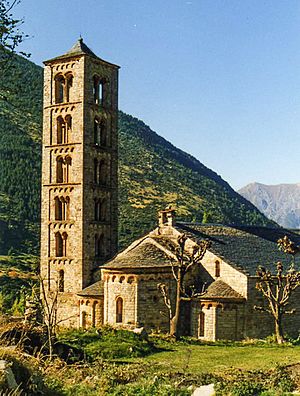
The church of Sant Climent in Taüll was officially opened on December 10, 1123. It sits on a small hill near the road between Taüll and Boí. This church is the largest and best-preserved one in La Vall de Boí. It is also considered the most impressive in terms of its architecture.
The church is built like a basilica, which means it has three long sections called naves. These sections are separated by rows of arches and end in a rounded part called an apse. The church still has its original wooden roof. To the side of the church, there's a tall, six-story bell tower with arched windows on each floor. The building is made from strong granite blocks, with lighter pumice stone used for decorations and windows. The outside walls have decorative patterns and pillars.
A very famous painting of Christ Pantocrator (Christ as Ruler of All) was originally in the main apse of this church. It is now kept at the National Art Museum of Catalonia (MNAC) and is known as a masterpiece of Romanesque art.
Santa Maria Church in Taüll
The Santa Maria church is also in the village of Taüll. It was officially opened on December 11, 1123, just one day after Sant Climent. It also has three naves, each ending with an apse. Its bell tower is built into the southern nave. The stonework of the bell tower is not as good as the rest of the church, which might mean it was built earlier, and the church was added around it.
The church was changed a lot in the 1700s, with a dome being added. Its beautiful frescoes (wall paintings) were moved to MNAC around 1918. Many of the 18th-century changes, including the dome, were removed in the 1970s to bring it closer to its original look.
Sant Feliu Church in Barruera
The Sant Feliu church is just north of Barruera. This village is in an important spot where the valley gets wider. In the Middle Ages, it was connected to a nearby abbey that no longer exists. The church originally had three naves, but only one remains. It has a rounded ceiling and a semicircular apse. There's also a square section and apse to the south, and a square chapel to the north. A simple bell tower stands at the southeast corner. Changes were made in the 1500s, adding two Gothic chapels and a Gothic front entrance.
Sant Joan Church in Boí
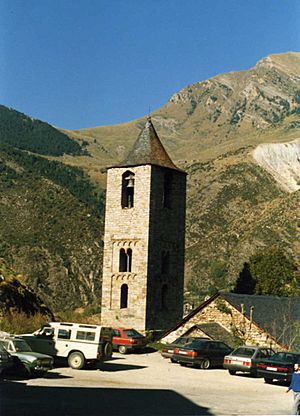
The Sant Joan church is at the entrance to the village of Boí, which gives the valley its name. The church has three naves, with apses at the eastern ends of the two side naves. The original wooden roof has been replaced with stone. The bell tower is to the south of the southern nave. The church was changed a lot in the 1700s, but many of these changes were removed in the 1960s. Its paintings were moved to MNAC in 1919.
Santa Eulàlia Church in Erill-la-Vall
The Santa Eulàlia church in Erill-la-Vall has one long nave with three apses at the eastern end. The entrance is to the north, leading to a covered walkway. A wooden roof has replaced the old rounded ceiling. The six-story bell tower stands tall at 23 meters (about 75 feet) to the north. This church is famous for an important wooden sculpture called Descent from the Cross, also known as the Erill la Vall Descent from the Cross.
Santa Maria de l'Assumpció Church in Cóll
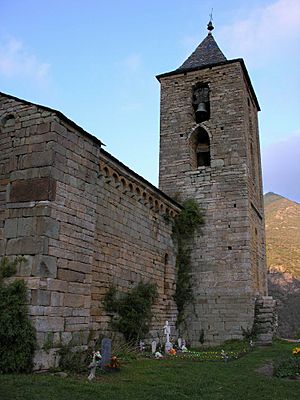
The Santa Maria de l'Assumpció church is located outside the village of Cóll. It was built with a single nave, an apse, and a rounded ceiling. It was officially opened in 1110. Later, Gothic additions were made. A side-chapel to the north and a later Gothic bell tower with two stories to the south give the church a cross shape. The inside is lit by round windows at both ends, and the main door is on the west side. The bell tower is currently in poor condition.
Santa Maria Church in Cardet
Cardet village is built on a rocky hill at the valley's entrance. The Santa Maria church is at the eastern edge of the village, on a steep slope. The church has one nave and an apse, with a crypt (an underground room) below the apse because of the sloping ground. A sacristy (a room for church items) was added to the southeast, and a chapel was added to the north side. The outside still shows parts from the 11th century, as well as changes from the 12th, 13th, 17th, and 18th centuries. The inside looks more Baroque due to later changes.
Nativitat de la Mare de Déu Church in Durro
The small town of Durro is high up at 1,386 meters (about 4,547 feet) on a mountainside facing south. The church has one long, narrow nave with a rounded ceiling and a slate roof. It was built with a single apse, which has now been replaced by a sacristy. Two square chapels have been built into the northern wall. The bell tower rises from the northeast corner and has five stories. The entrance is on the southern wall, leading to a covered walkway. The building has been changed and made bigger many times since it was built in the 12th century, so little of its original look remains. The inside still has Baroque features from later changes.
The church was restored in 1983, and the bell tower was fixed in 1994.
Ermita de Sant Quirc in Durro
The small hermitage of Sant Quirc is on a rocky hill near Durro. It has a small nave and an apse, with an entrance on the south side. A short belfry (a small bell tower) stands at the west end. The space above the roof, which can be reached from outside, might have been used to store grain.
Images for kids
See also
 In Spanish: Valle de Bohí para niños
In Spanish: Valle de Bohí para niños




